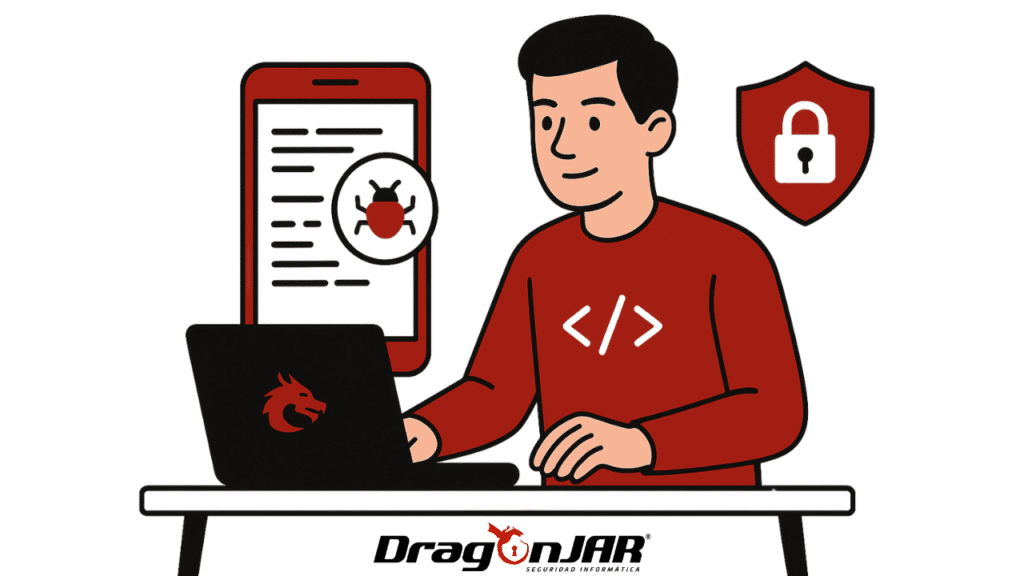Mobile Application Penetration Testing
Mobile applications have become the core of our daily activities, playing a fundamental role in almost every routine, whether using Android or iOS devices. To ensure the cybersecurity of these applications, Mobile Application Penetration Testing is crucial. DragonJAR SAS provides an effective strategy to identify and remediate vulnerabilities in your organization’s apps.

Importance of Mobile Application Penetration Testing
Android Application Penetration Testing
Android is the world’s most popular mobile operating system, exposing your APK to countless eyes—some of which have malicious intent. Due to its widespread adoption, Android apps attract both a vast user base and threat actors eager to exploit any detectable weakness. Regular Mobile Application Penetration Testing on every APK in your organization is essential to validate security and protect sensitive data. This process uncovers flaws in both the app itself and any web resources it uses, as well as issues in the source code.
iOS Application Penetration Testing
iOS, renowned for its robust security and dominance in the premium device market, supports a vast ecosystem of applications. However, iOS apps face their own security challenges. That’s why exhaustive Mobile Application Penetration Testing on every IPA is vital—examining configurations and source code to identify and mitigate vulnerabilities. This ensures continuous protection of sensitive data and strengthens defenses against emerging threats.
Benefits of Mobile Application Penetration Testing
- Improved Security Posture: Beyond mere vulnerability detection, Mobile Application Penetration Testing enforces robust authentication mechanisms and enhances encryption practices, significantly strengthening overall app security.
- Attack Prevention & Data Protection: By proactively identifying potential attack vectors, penetration testing acts as an effective prevention mechanism, stopping exploits before they can be leveraged in real-world attacks.
- Standards Compliance: Testing is essential for verifying that mobile apps meet international security standards such as PCI DSS, boosting both security and market credibility.
Integrating Mobile Application Penetration Testing into the software development lifecycle ensures that mobile apps are secure and reliable before release. This process protects user data and privacy, while reinforcing the integrity and reputation of your digital solutions.
Mobile Penetration Testing Process at DragonJAR SAS
At DragonJAR, mobile app testing goes beyond static code analysis (SAST) and dynamic security testing (DAST) with tools like MOBSF, Frida, and Objection. We deeply analyze application logic, workflows, and interactions with external systems and APIs. This comprehensive approach uncovers both technical vulnerabilities and logic/design flaws that could be exploited during Mobile Application Penetration Testing.
Beyond the OWASP Mobile Top 10 2024
The OWASP Mobile Top 10 2024 highlights the most critical mobile security risks. At DragonJAR, we don’t stop at these ten risks—we extend our testing to cover:
Secure Your Future: Elite Cybersecurity Solutions for Modern Businesses
- Improper Credential Handling (M1): Poor management of credentials leading to unauthorized access.
- Supply Chain Weaknesses (M2): Risks in software dependencies and supply chains.
- Insecure Authentication/Authorization (M3): Flaws that allow bypassing access controls.
- Insufficient Input/Output Validation (M4): Lack of proper data validation, enabling injection attacks.
- Insecure Communication (M5): Weak encryption or protocols that expose data in transit.
- Poor Privacy Controls (M6): Inadequate handling of personal data.
- Weak Binary Protections (M7): Insufficient obfuscation and reverse-engineering defenses.
- Misconfiguration (M8): Configuration errors that leave apps vulnerable.
- Insecure Data Storage (M9): Improper handling of sensitive data at rest.
- Weak Cryptography (M10): Flawed or inadequate cryptographic implementations.
We also develop custom scripts for advanced testing, ensuring a deeper, tailored security assessment during every Mobile Application Penetration Testing engagement.
Frequently Asked Questions about Mobile Application Penetration Testing
How are applications protected against hackers?
Mobile Application Penetration Testing combines static and dynamic analysis to identify and mitigate vulnerabilities. Tools like Burp Suite intercept and analyze traffic for malicious code and man-in-the-middle attacks, strengthening overall security.
What open-source tools are used for code analysis?
We leverage open-source tools such as Android Debug Bridge (ADB) and platform SDKs, alongside traffic interception tools like Burp Suite, to decompile, scan, and test mobile apps for vulnerabilities.
Can tests be performed on rooted or jailbroken devices?
Yes. Testing on rooted or jailbroken devices provides deeper system access, allowing more thorough vulnerability analysis—particularly useful for assessing how apps handle and store sensitive information.
Conclusion
Mobile Application Penetration Testing is essential to safeguard your applications and the data they handle. At DragonJAR SAS, our team of experienced pentesters is ready to secure your mobile solutions. Contact us to ensure the integrity and confidentiality of your digital assets.

Leave a Reply